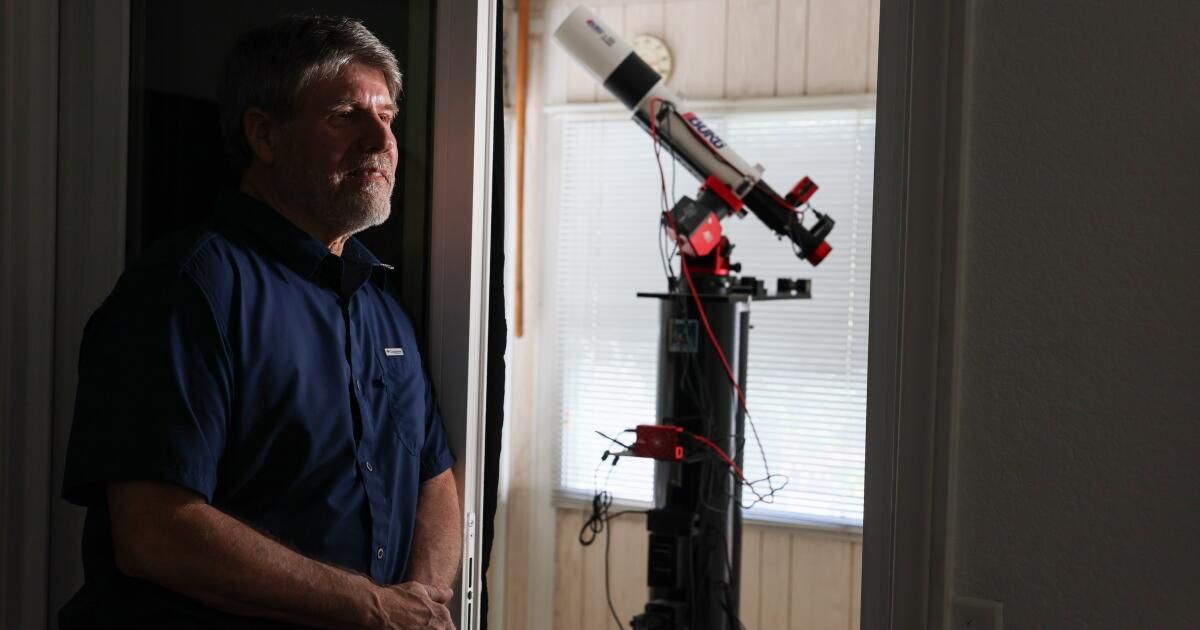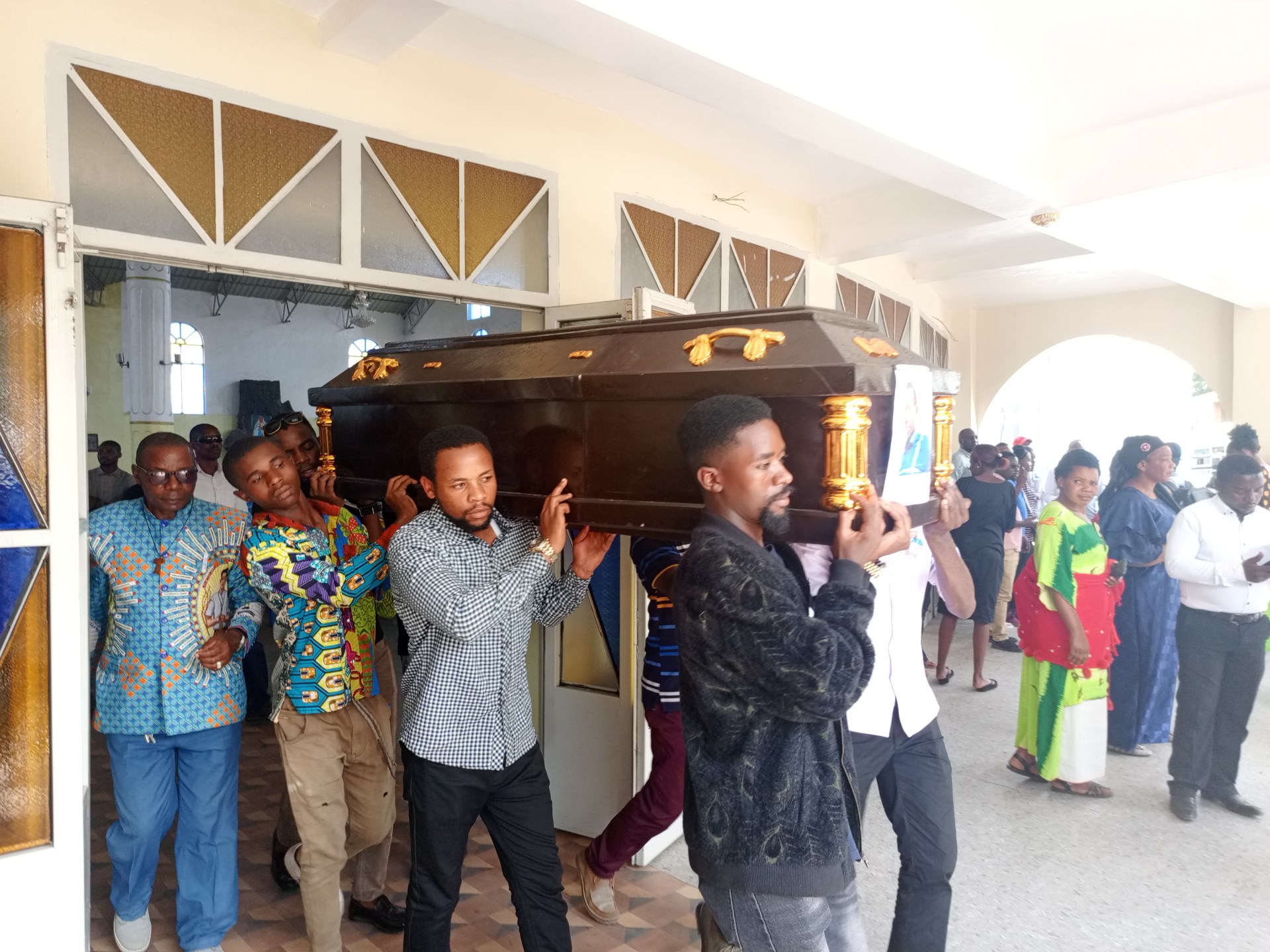Every clear night for the past three weeks, Bob Stephens has pointed his home telescope at the same two stars in hopes of witnessing one of the most violent events in the universe: a nova explosion 100,000 times brighter than the Sun.
The eruption, which scientists say could occur at any time, has sparked interest from major observatories around the world and promises to improve our understanding of turbulent binary star systems.
Yet for all the high-tech observing power that NASA and other scientific institutions can muster, astrophysicists are dependent on countless amateur astronomers like Stephens to spot the burst first.
The reason? It's too expensive to keep the team focused on the same topic for months at a time.
“I think everyone will be watching it as it happens, but sitting there watching it isn’t going to make it happen,” said Tom Meneghini, director of telescope operations and executive director emeritus of Mount Wilson Observatory. “It’s like a watched pot,” he joked.
The star is so far away that its light takes 3,000 years to reach Earth, meaning the explosion occurred before the last Egyptian pyramids were built. It will appear as bright as the North Star for a few days before fading into darkness.
Once sighted, some of the most advanced observatories on Earth and in space will join in the observation, including NASA's James Webb Space Telescope.
“A lot of people are eagerly awaiting a glimpse of the new crown jewel,” said Mansi Kasliwal, a Caltech astronomy professor who plans to use Palomar Observatory in northeastern San Diego County to observe the event. The nova will erupt in the constellation Corona Borealis, or Northern Crown.
Steve Flanders, Palomar Observatory outreach coordinator, shows off the observatory's Gattini-IR telescope, which Caltech professor Mansi Kasliwal's team will use to observe the Blaze star explosion.
(Hayne Palmour IV/For The Times)
T Coronae Borealis, also called the Shining Star, is actually two stars: a hot, dense white dwarf and a cooler red giant.
The dwarf star, which ran out of fuel long ago and collapsed to about the size of Earth, has been siphoning hydrogen gas from its larger neighbor for about a human lifetime.
This stolen gas has accumulated into a disk around the dwarf, like a hot, messy version of Saturn's rings. Soon, the disk will become so heavy that it will become violent and unwieldy, and inevitably, it will explode like a thermonuclear bomb.
But none of the stars are destroyed and the process repeats approximately every 80 years.
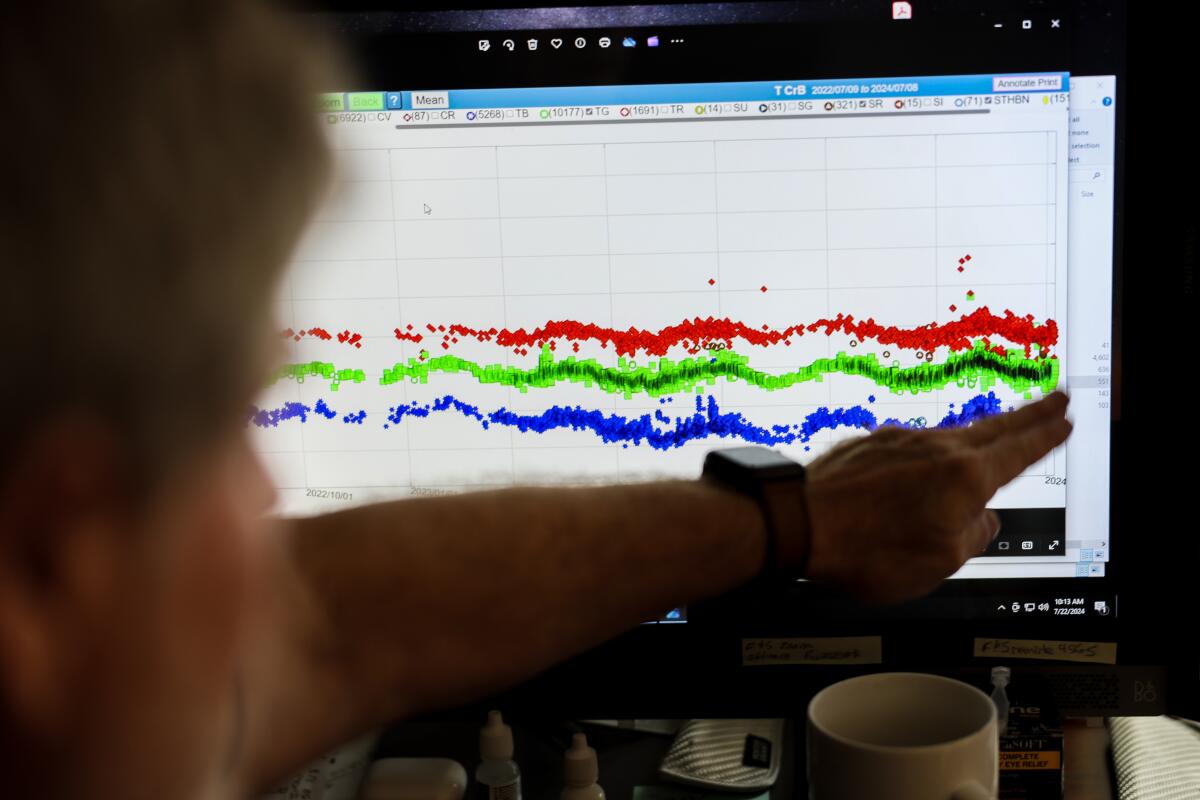
Stephens has data for T Coronae Borealis going back years. The wobbles in the data represent the two stars orbiting each other.
(Robert Gauthier/Los Angeles Times)
This time, there's an army of enthusiasts like Stephens ready to sound the alarm when the star goes nova.
Far from being mere hobbyists, several of these amateur observers have published their own scientific research. Stephens even built his own observatory as an annex to his home in Rancho Cucamonga.
“The city thinks it's a solarium,” Stephens said. After the inspector drove by, he removed the screws holding the roof in place, allowing him to remove it and reveal the clear sky before his telescope.
Each night, he turns on the telescope and spends more than an hour taking data, which he then posts to an online community of amateur astronomers who monitor the star almost non-stop.
Large observatories simply cannot maintain such constant surveillance. Hundreds of scientists compete for time to observe a wide range of astronomical targets each night. For them, keeping these telescopes glued to the Blaze Star is a waste of valuable observing time.
Estimates of when the nova will occur vary, but most astrophysicists agree it will happen before the end of the year, and probably in late August.
Once it explodes, some alert systems have been set up to notify amateurs and professionals. Some observatories have even programmed their telescopes to autonomously abandon their current observing plan and observe the star when the notification comes, Stephens said.
Major observatories also face another complication. Many of their telescopes are designed to observe the faintest, faintest targets, but Blaze Star's nova will be anything but faint. Pointing these telescopes at the nova would overload the sensors, resulting in a washed-out, overexposed image.
That’s why Palomar Observatory, Caltech’s research station in northern San Diego County, isn’t using its iconic 16-foot-wide Hale telescope under its massive white dome. Instead, it’s using a much smaller telescope, called Gattini-IR, housed in a small, unremarkable brick building about a quarter mile from the road.
Once the nova occurs, Gattini-IR will switch from observing the Blaze star every other night to every two hours.
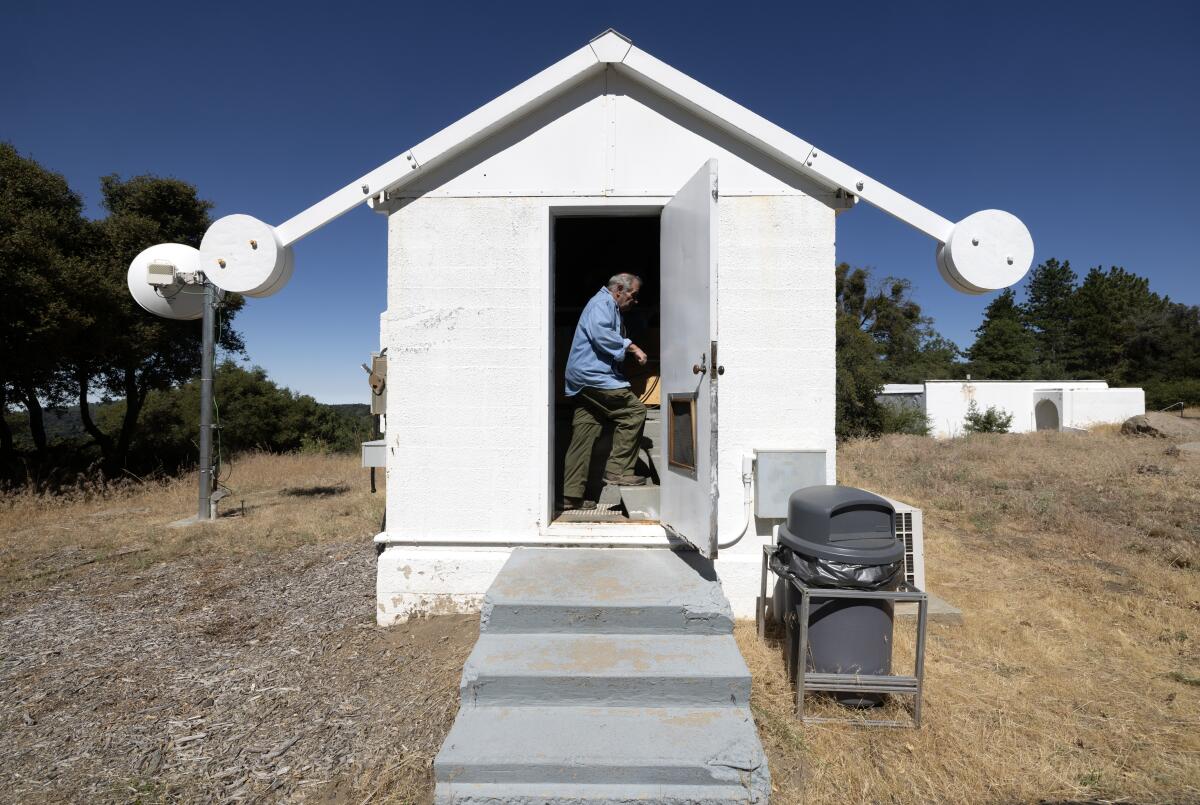
Steve Flanders walks into the small building at Palomar Observatory where the Gattini-IR telescope is installed. The Gattini-IR telescope is monitoring the star Blaze, which is expected to become a nova.
(Hayne Palmour IV/For The Times)
Scientists say they still have a lot to learn about novae. For example, physicists are still unsure why some erupt. Every decade While others probably don't. millennia.
Some researchers suspect that novae like the Blaze Star could be precursors to supernovae. These explosions, billions of times brighter than the Sun, destroy the star and often leave behind a black hole. Supernovae are also a useful tool for astronomers to measure distances.
However, the study of similar events has already led to discoveries.
Recently, scientists determined that novae tend to eject material into space at faster rates than would be predicted based on the intensity of the explosion.
“We want to understand the physics of novae, so having a nova as close as T Coronae Borelias, which we hope will be very well studied by all the telescopes… we can get a very complete picture,” said Caltech’s Professor Kasliwal.
Part of that understanding will be due in part to amateur astronomers.
Thanks to the rapid development of telescopes, amateurs are working with technology that professionals didn't have just 20 years ago, let alone 80, said Forrest Sims, an amateur astronomer in Apache Junction, Arizona, who also observes the star every clear night.
And amateurs can achieve better coverage than large telescopes because “we usually have complete control over when and where we can point.” [our telescopes]“Sims said. “A professional may have to apply for a grant to be able to spend a half hour or two hours at a large telescope.”
That allows them to collect a huge amount of data. And with hundreds of community members watching from around the world, they can achieve near-continuous coverage of the Blaze Star. Many, including Sims and Stephens, post their data on Website of the American Association of Variable Star Observersallowing everyone to use the data.
Stephens recalls reading a journal article by a professional who had managed to observe five asteroids in two years. “I thought I could do it in a month,” Stephens said. He later published a paper with ten observations.
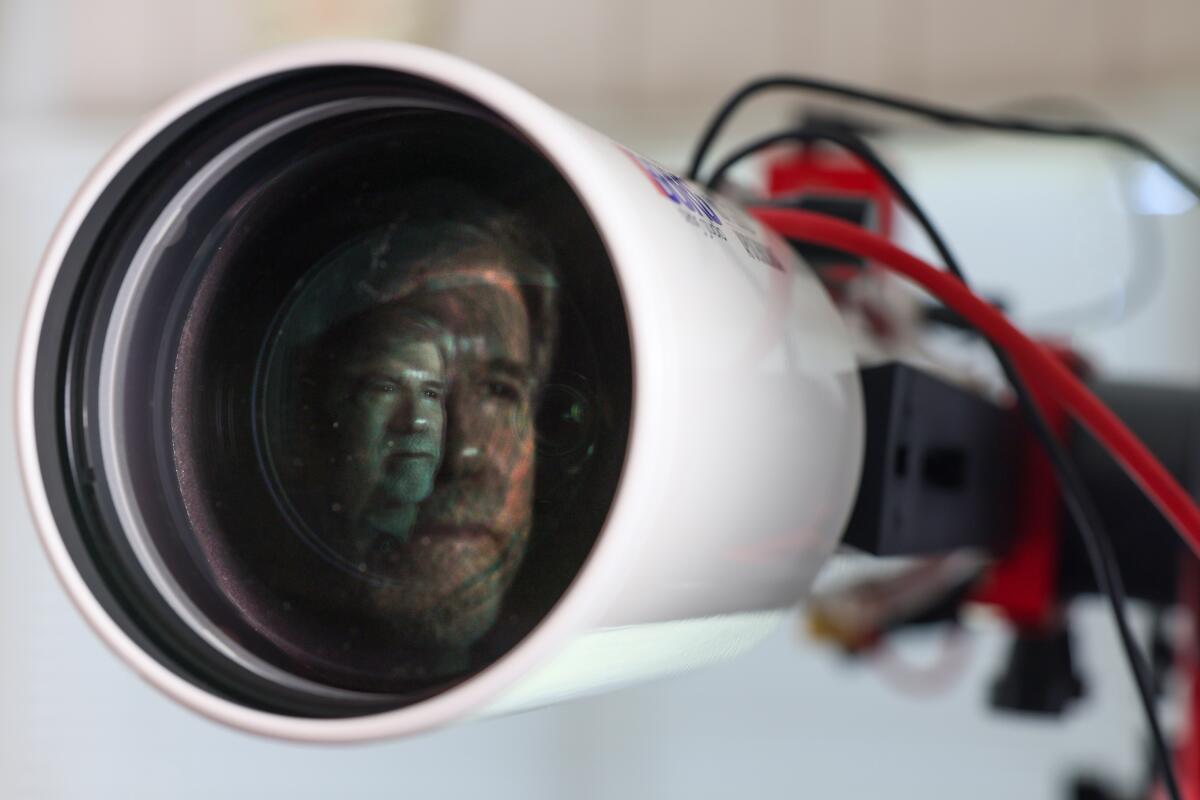
At his home observatory, Bob Stephens uses a Borg 101 telescope. “Resistance is futile!” Stephens said as he introduced the telescope, a reference to a line uttered by “the Borg” in “Star Trek.”
(Robert Gauthier/Los Angeles Times)
One professor was so amazed by the number of objects Stephens could see that she contacted him and agreed to travel to Puerto Rico to attend a conference on asteroids just to meet him. They ended up working together: Stephens had the telescopes and she had the connections in the field.
Today, the work of amateur astronomers is becoming so sophisticated that many in the field find it difficult to call them amateurs.
“We call ourselves ‘small telescope scientists,’” Sims said. “It sounds more fun, and in some ways professionals will – and not unwillingly – admit that the work we do is often of a professional calibre.”

